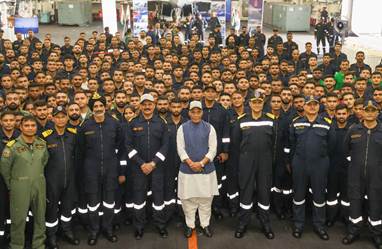Defence Minister Rajnath Singh termed Operation Sindoor as India’s bold and decisive response to terrorism, emphasizing that the mission is “not over, but just a pause.” Addressing officers and sailors aboard India’s first indigenous aircraft carrier, INS Vikrant, off the Goa coast on Friday, Singh delivered a powerful message to Pakistan: any future misadventure will be met with the full force of the Indian Navy.
“Operation Sindoor is not just a military action, it is India’s frontal assault on terrorism,” said Singh. “If Pakistan indulges in any unethical or hostile acts, it will face the firepower and resolve of our Navy.”
The Defence Minister praised the Indian Navy’s silent yet impactful role during the operation. He said the powerful Carrier Battle Group played a crucial role in keeping the Pakistani Navy confined to its ports, ensuring it did not intervene during the coordinated Indian military response.
Sending a strong message to Islamabad, Singh stated, “The time is up for the dangerous game of terrorism that Pakistan has played since Independence. India will not hesitate to take every necessary step to eliminate terrorism.” He reiterated that India retains the right to act against terrorist threats both across the border and in the seas, and called for Pakistan to hand over terrorists Hafiz Saeed and Masood Azhar—both UN-designated and accused in the 2008 Mumbai attacks.
On the subject of talks with Pakistan, Singh was clear: “Dialogue will only happen on terrorism and Pakistan-occupied Kashmir (PoK). If Pakistan is serious about talks, it should first hand over the terrorists to India so that justice can be delivered.”
Commending the Navy’s role in Operation Sindoor, Singh detailed the precision and readiness of India’s maritime forces. Within 96 hours of the April 22 Pahalgam terror attack, Indian naval units conducted successful missile and torpedo firings along both the western and eastern seaboards. The Navy’s aggressive deployment and coordination with the Air Force during airstrikes on terror bases underscored the seamless integration among India’s armed forces.
He emphasized the power projection of the Carrier Battle Group as a symbol of India’s intent and capability. “The Indian Navy’s combat acumen and strategic might have broken the morale of the enemy,” he said, urging continued operational preparedness.
Rajnath Singh highlighted the transformation of the Indian Navy into a strategic force that extends beyond regional responsibilities. “Today, the Navy is not just the guardian of the Indian Ocean but a force that projects India’s growing global influence,” he said, noting the Navy’s growing focus on cyber, data dominance, and strategic deterrence.
Drawing a historical parallel, Singh recalled the pivotal role played by the original INS Vikrant during the 1961 Liberation of Goa. Now in its modern incarnation, the carrier once again leads India’s maritime resolve against terrorism.
Singh was accompanied by Chief of the Naval Staff Admiral Dinesh K Tripathi, Flag Officer Commanding-in-Chief of the Western Naval Command Vice Admiral Sanjay J Singh, and other senior officials. He also reviewed frontline warships that were part of the Carrier Battle Group during the operation.










